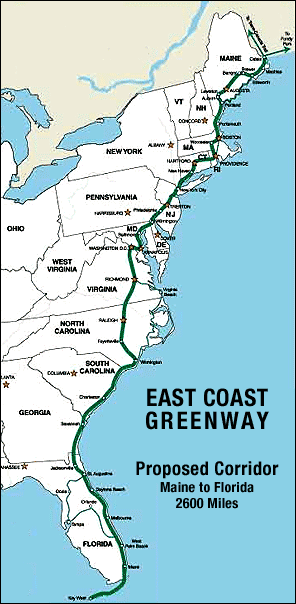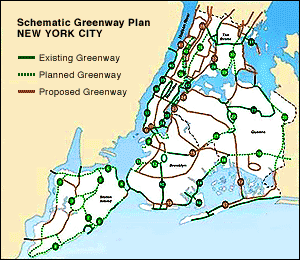 |
|
It took New Yorkers to come up with an idea as big as the East Coast Greenway, a trail that would extend from Maine to Florida. And, though it is now almost a reality, it could take just a few minor, shortsighted decisions by the City of New York to short-circuit the route in the city, sending it instead over the George Washington Bridge to New Jersey.
Unlike the Appalachian Trail, the East Coast Greenway would go right through the central business district of every big city on the coast. Thousands of visitors would use it for recreation, for exercise, to see the sites - ecotourism - but perhaps its more important purpose would be as practical transportation by pedestrians and bicyclists who reside in places like New York City. Indeed, local activists and government officials developed the idea of the East Coast Greenway as part of the effort to sell an equally ambitious effort within city limits, the 350-mile New York City Greenways System.
Your string section may be playing "impossible dream" in the background at this point, but the East Coast Greenway Alliance, founded by practical professionals from up and down the coast, knew what they were doing. The fact is, the East Coast Greenway is mostly in place within New York City, and all remaining links . are on the Department of City Planning's Greenways Plan for NYC. There is no long-term obstacle to bringing the East Coast Greenway to lower Manhattan, which is remarkable considering that we are talking about what may be the most densely developed property on the planet.
When New Yorkers began all this talk of bicycle/pedestrian trails they were building on the legacy of Fredrick Law Olmsted, the 19th century designer of Central and Prospect Parks, and Robert Moses, the 20th century's master builder of bridges, highways and parks. Both laced the city with "parkways" containing bicycling paths. At the beginning of this new round of the planning process, just 15 years ago, lack of funding was considered the biggest impediment to the construction of a linked bicycle network. But the federal government has so far given $150 million to develop the Hudson River Park's greenway, which is the most successful in the nation, connections have been completed to the George Washington Bridge, and New York's elected officials are jumping aboard: In his first State of the City speech, Mayor Michael Bloomberg announced plans to complete "a multi-use recreation path around the entire edge of Manhattan. The success of Hudson River Park demonstrates the need to make our entire waterfront accessible to walkers and cyclists." At the future site of the Brooklyn Bridge Park, which will include a greenway link through its site, Governor George Pataki recently held a bicycle aloft and proclaimed: "I can't wait until I can ride the entire Brooklyn waterfront on this bike!"
But in New York City no good idea is easy to achieve and there are several wrenches in these works. A planned street reconstruction that would place water mains below the Columbia Street neighborhood south of the Brooklyn Bridge could leave the an early segment of the greenway in place without additional construction cost, but the city Department of Transportation desires to widen a lightly used truck route through the working class district to accommodate more traffic. The street widening would cut an existing 15-foot sidewalk along the Red Hook Containerport to just six feet wide, effectively killing the landscaped greenway and making it dangerous to walk two abreast.
 |
|
MTA Bridges and Tunnels, the agency that manages the Verrazano Bridge, has no desire to transport pedestrians over the Narrows and has repeatedly claimed winds are dangerous on the bridge. But the Golden Gate Bridge, in the windier city of San Francisco, handles thousands of pedestrians with grace and style.
On Staten Island, greenway development moves forward on the northwest shore, but thus far, an interim trail on the abandoned Staten Island Railroad has been elusive at best. And the Port Authority has closed down the Goethals Bridge pedestrian path for repairs, a project that has taken more than 10 years so far without an announced re-opening.
Over the years, New York City has earned two conflicting reputations. We are considered pioneers in public space development even though we have fewer acres of parkland per capita than other places. But New York is also considered dysfunctional; a place where things just can't get done. It would be sad for a few broken links on a national recreational trail that will eclipse the Appalachian Trail to foil the East Coast Greenway Alliance's vision of passing through the major central business districts along the coast. It will take intervention by citizens groups and elected officials to see that that does not happen.
Dave Lutz is executive director of Neighborhood Open Space Coalition and a board member of East Coast Greenway Alliance.




